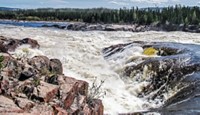Advertisement
Grab your lab coat. Let's get started
Welcome!
Welcome!
Create an account below to get 6 C&EN articles per month, receive newsletters and more - all free.
It seems this is your first time logging in online. Please enter the following information to continue.
As an ACS member you automatically get access to this site. All we need is few more details to create your reading experience.
Not you? Sign in with a different account.
Not you? Sign in with a different account.
ERROR 1
ERROR 1
ERROR 2
ERROR 2
ERROR 2
ERROR 2
ERROR 2
Password and Confirm password must match.
If you have an ACS member number, please enter it here so we can link this account to your membership. (optional)
ERROR 2
ACS values your privacy. By submitting your information, you are gaining access to C&EN and subscribing to our weekly newsletter. We use the information you provide to make your reading experience better, and we will never sell your data to third party members.
Environment
Mercury Found In Fish Living In Pristine Lakes
by Britt E. Erickson
April 28, 2014
| A version of this story appeared in
Volume 92, Issue 17

Federal researchers have found mercury in all fish tested from remote lakes and streams in 21 national parks in 10 western states, but the mercury levels in most of the fish were below the threshold for potential health effects in fish, birds, and humans. The study was conducted by the National Park Service and the U.S. Geological Survey from 2008 to 2012. More than 1,400 fish, including brook, rainbow, and lake trout, from 86 lakes and rivers were tested. Smaller fish consumed by wildlife were also sampled. Mercury levels varied greatly from park to park and within each park. Grand Teton and Great Basin National Parks had the lowest percentage of fish exceeding the threshold for unlimited human consumption, and Glacier National Park had the highest, with 100% of its fish exceeding that threshold.





Join the conversation
Contact the reporter
Submit a Letter to the Editor for publication
Engage with us on Twitter